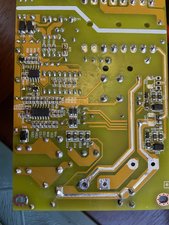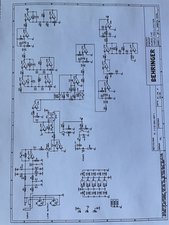Behringer b212d Blowing Fuses
Hi there! I have a Behringer B212D powered speaker that keeps blowing fuses. I opened it up and see I have 2 MOSFETS that have blown up on the primary side of the switch mode power supply. I haven’t been able to locate any shorts on the primary side, but I hear that when the fets blow and the fuse blows, there are likely other parts that got taken out as well. I’ve checked all the resistors and capacitors and diodes and can’t find any parts that measure faulty or show a short. I’ve also used an ESR tester on all the electrolytics.
I read somewhere that when the fets blow, the IC that regulates the switching of the fets gets taken out as well. I’ve taken out the 2 blown up fets and was thinking of powering up the SMPS with a light bulb limiter to see if I could measure the voltage coming into the IC, but I read somewhere that you should replace both the IC and fet, because if you don’t, then whichever part you leave in will cause the other part to blow again. That is, if I replace the fets only and if the IC is blown, the IC will cause the new fets to blow.
So my question is, should I replace the IC and fets together? Can I try powering up the board without the fets and see if I’m getting voltage to the IC, or is it likely I’ll blow something else up? The schematic is for a B215D which is very close to the B212D I have. The main difference is it has a 15” speaker, where mine has a 12” speaker. Unfortunately the schematic came out blurry where the original is not. I’ll see what I can do to get it clearer. Thank you!






Is dit een goede vraag?

 2
2 
 374
374  1,5k
1,5k
15 opmerkingen
@billguitarvin first it may help if we can see what you are looking at. So try and ost some images with your Question. Next, yes, there is a reason why those MOSFETS went up in smoke. Could be the IC. The way I would approach it is by replacing what blew up first. Then check the IC. If you have the schematics, then you can do your checks before. Without schematics, you will need to find the datasheet for the IC and see what is going on with it. Nothing is ever really easy without schematics.
Voeg afbeeldingen toe aan een bestaande vraag
door oldturkey03
Thanks oldturkey3 for your reply! I will post some pictures and the schematic. The schematic I have is for the B115D which is almost the same design but has a15” woofer instead of the 12” I have.
door Bill Garvin
@billguitarvin Check your Diodes. D41 looks a bit crusty and why is D37 all cockeyed :-)
door oldturkey03
Thanks oldturkey! I really appreciate you taking time to look over the board. You are right, D41 looks pretty crusty, but with red probe on anode and black probe on the cathode, with the multi meter in diode mode, I get .482 voltage drop. With the probes reversed I get a voltage drop of 1.961. I get pretty much the same readings from D49, which goes to the other mosfet T2. Since I’m not getting the meter to read OL when I reverse the probes, could this be due to one of the other resistors in the circuit, or should I take D41 out of the circuit and test it?
door Bill Garvin
Oldturkey, as far as D37 being cockeyed, I’m not sure. This is the 1st time I’ve opened up the powered speaker. Perhaps due to a hangover or is it a rebel who likes to be different? 🙂
door Bill Garvin
10 commentaren meer tonen